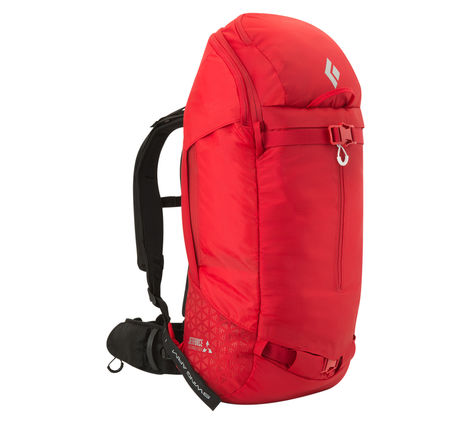Airbags 2015 – What to do?
Throughout my backcountry ski life, a number of devices have come along that obviously one should have when traveling in avalanche terrain. From an earplug as an audio finder attached to a $60 Ramer Beacon in the early 80’s, to the digital age beacons that include a whiz-bang list of features for various applications, the problem of avalanche survivability remains the biggest safety issue to backcountry skiers. Since about 2004, the BD Avalung Pack has served has my last ditch device to add a few minutes to a successful recovery from a nearby rescuer. But has someone who has spent the vast days of my days solo in the complicated terrain of the Chugach, the beacon serves me little purpose as a rescue tool.
1982 Ramer Avalanche Beacon. Note folded paper to hold battery against contacts. It also worked for Euro batteries without this modification.
Today, Airbags are the rage and for good reason for a soloist. The fact that they can increase your chances of not dying to 50% is still sounds like a flip of the coin, verus betting on a royal flush.
A balloon that is easily deployed to keep you on top of the white wave of an avalanche has already saved a number of backcountry skiers around the world is undeniable. The simple reason they are not more common and saving more lives is price. Another common reason is air travel as it carries a pressurized cylinder. And, they definitely add weight to an already burdened skinner. At $1000 a pop, skiers have to make a substantial financial decision along with the human factor of “Why don’t you have one? I do.” I recall my first Avalung costing slightly more than a quality daypack at the time.
I have yet to buy one, as I’m waiting for more beta from the lighter, battery operated JetForce Avalanche Airbag by Black Diamond now in it’s first season. There were only a few companies offering an airbag in 2008. Now you can select from literally a dozen brands that offer pressurized systems. (and heavily reviewed elsewhere.)
Wether you buy one or not is a personal choice, but they have been used with success and deserve a serious look. The numbers are rolling in to provide some analysis of their success or lack of as it turns out. It’s important to note that like carrying a beacon, what takes place in your head as you make route decisions is the number one way to avoid getting caught. The primary cause of which is ignoring common clues.
But of all the avalanches devices I’ve seen developed over the years, this one does unfortunately give some the confidence that they can actually survive riding a one-hundred mph avalanche on your next stride or turn. This is troublesome as the statistics below bear out along with terrain complications like cliffs and trees. I’ve never felt that way with an Avalung as you knew the device was only useful you got the tube was in your mouth as you were buried and had a rescuer nearby. That was enough negative vibes to temper the notion that I could survive an avalanche.
I grabbed this below points off a discussion on airbags on Lou Dawson’s Wild Snow online backcountry blog. It was snagged off a German study completed in early 2014.
I would print the study here and let them give you their analysis, but I think I will leave that to you. But airbags are not the total panacea we had hoped for based on some of their conclusions.
1. More people die while wearing an airbags than expected.
2. Risk of death without airbag is 22%, with airbag inflated is 11% (preventing 50% of deaths).
3. In 20% of all cases airbags were not inflated (among people who were wearing an airbag).
4. When not inflated airbags are taken into account, risk of death is reduced to 13% (Instead of 11%, preventing 41% of deaths)
5. 60% of all cases where airbags where not inflated are due to not taking any action to inflate the airbag.
6. Gain of safety is reduced to zero when people use the security of airbags to go into areas where big avalanches are possible

